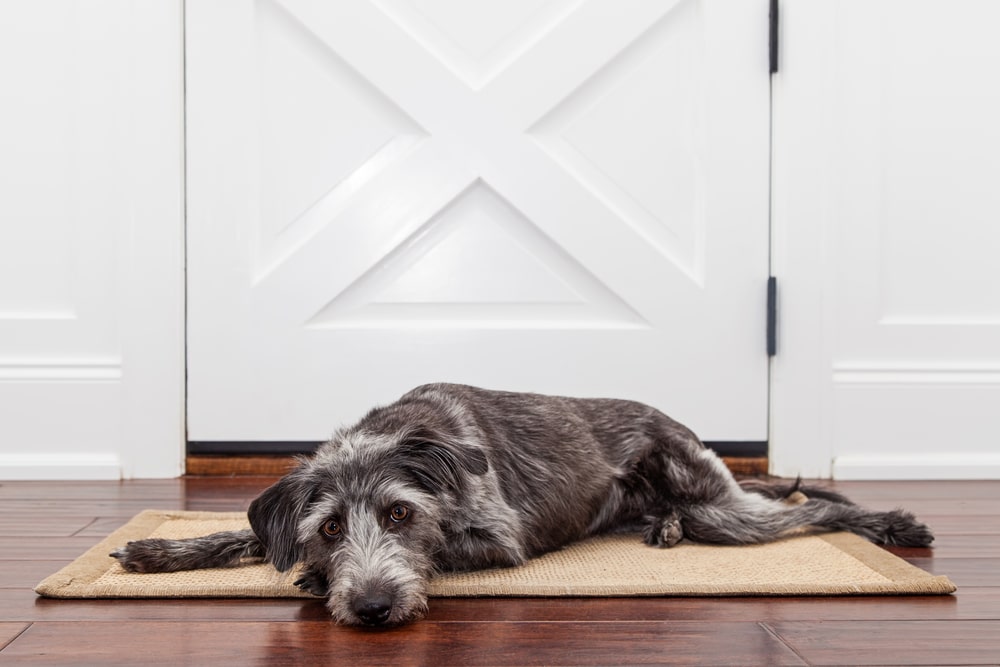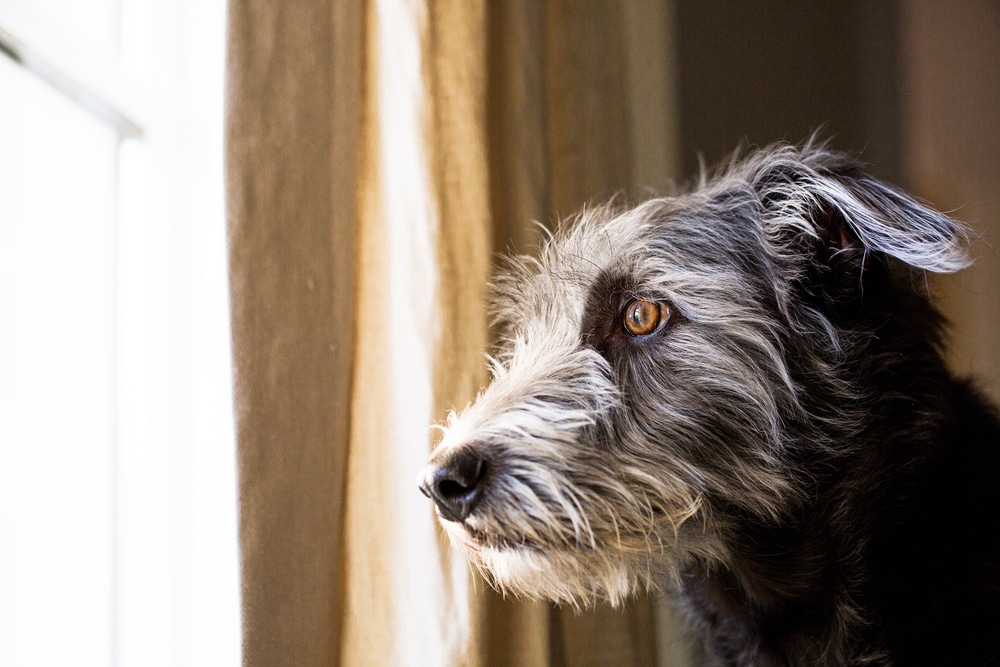If your dog seems overly attached to you or frequently destroys your house while you’re away, your furry friend may have separation anxiety. This can be extremely distressing for both dogs and their pet parents. But what exactly is separation anxiety and how can you manage it?
Separation anxiety is a panic response that occurs in dogs. This happens when they are separated from the person or people they are closest to. When dogs are alone like this, this usually results in destructive behavior (chewing, scratching), attempts to escape, excessive vocalization, and urination or defecation in the house. Training and making changes to the owner’s departure and return help manage mild cases. More severe cases will often need the above as well as anti-anxiety medication and even referral to a veterinary behaviorist.
Table of Contents
What Is Separation Anxiety In Dogs?

Separation anxiety is a panic response that occurs when a dog is separated from their loved ones. This usually happens when they are left alone in the house. The behaviors associated with separation anxiety may include the following:
- Chewing, scratching, and other destructive behavior. Often this is aimed at doors or windows as the dog tries to escape and find their owners. This behavior may cause harm to a dog’s nose and/or paws.
- Excessive vocalization such as barking, whining, and howling.
- Urination and defecation in the house from a dog that has been previously housetrained.
- Other signs of anxiety such as panting, pacing, drooling.
If these behaviors occur in the owner’s presence, then it is not separation anxiety. It may instead be a sign of a lack of training or another type of behavioral issue. However, dogs with separation anxiety may appear especially attached to their people, following them from room to room or wanting to constantly touch them.
Separation anxiety can occur based on a dog’s individual temperament. But stressful events or changes in routine often trigger it. Examples include moving houses, relinquishment and adoption at an animal shelter, or their owner working a new schedule. It can occur in dogs of any age, however it may get worse over time if left untreated.
How Do Veterinarians Diagnose Separation Anxiety?
Your vet will diagnose separation anxiety based on your account of what happens at home and the presence of the behaviors listed above.
What Is The Treatment For Separation Anxiety?
Treatment often involves a combination of the recommendations listed below. This condition can be extremely difficult to manage and is upsetting for both dog and owner. Therefore, it is always recommended to contact your vet, a well-respected trainer who uses positive training techniques, or a veterinary behaviorist to help guide and support you.
Now, here are some of the treatments that can help with separation anxiety.
Training/Behavioral Modification
There are many different theories about what type of training is most effective for dogs with separation anxiety. Dogs with mild cases may respond well to a few small changes, whereas those with more severe cases will likely need to follow a personalized step-by-step guide with an experienced trainer. Here are some types of training that may be beneficial in some cases.
Desensitization To Departure Cues
Some dogs begin to get anxious the moment they suspect you are about to leave them. You can try to break this association by determining which departure cues cause anxiety (such as putting on your shoes, picking up your keys), and then doing these things randomly throughout the day without actually leaving.
Independence Exercises
If your dog constantly wants to be next to you when you’re home, they may benefit from some independence exercises. This may involve teaching your dog to lay on a mat while you gradually move further and further away. Be sure to go slowly and reward calm, quiet behavior.
You may also practice giving your dog a chew toy or food puzzle when walking out of the room for longer periods of time. Eventually, your dog may feel comfortable when you leave the room and/or the house.
Absolutely No Punishment
Separation anxiety is a panic attack and as frustrating as it may be, punishing your dog will only serve to scare and confuse them.
Environmental Modification
This category involves changes you can make to your routine and your home to help your dog feel more comfortable while you are away. This may mean having someone stay home with your dog or sending them to doggy daycare until medications and training begin working.
It could also involve leaving your dog in a crate (if they are crate-trained and feel comfortable in their crate) or creating another safe and relaxing area for them. Leaving your dog with a special treat or puzzle food toy may keep them busy in mild cases of separation anxiety, or consider an automatic treat dispenser to periodically provide treats while you’re away.
Lastly, taking your dog on a long walk or having an active play session before you leave may help tire them out. Setting up a camera so you can check in on your dog while away can also be helpful to know what is working for your pup.
Medication
There are multiple prescription anti-anxiety medications available that are helpful in managing separation anxiety. Medication alone is unlikely to resolve the issue, but when paired with behavioral and environmental modifidation is often very successful. Medications help take the edge off so that your dog is not in panic mode, and is actually able to learn and respond to training.
There are several different types of medications, and your vet will decide which one to recommend for your dog. Just like with doctors and people, the vet may need to tweak the dosage or medication to find what works best for your dog. The vet will need to conduct a physical exam and do bloodwork prior to starting a medication protocol.
Short-Acting Medication
These medications, such as alprazolam, trazodone, clonidine, gabapentin, and Sileo, are medications that are short-acting, meaning they start working immediately and then wear off after a certain period of time. They generally help decrease anxiety and cause mild sedation.
They are best used for situational anxiety, such as before thunderstorms or veterinary visits. With separation anxiety, they may be used early in the course of treatment. Examples include if you have to leave your dog home alone before training and long-acting medication have taken effect.
Long-Acting Medication
These medications, such as fluoxetine (Prozac) and clomipramine take 4-8 weeks to become fully effective, and are meant for long-term use. They can be extremely helpful for many behavioral issues including generalized anxiety and separation anxiety. The most common side effects may include a temporary decrease in appetite, vomiting, and diarrhea.
Referral To A Veterinary Behaviorist
In complex cases it is best to consult a specialist. A veterinary behaviorist is a veterinarian who has received additional training and certification in the treatment of behavioral issues. They are often able to recommend a comprehensive treatment plan tailored to your situation.
Conclusion: What Is Separation Anxiety?
Separation anxiety is a serious condition that can cause significant distress in both dogs and their owners. Imagine not being able to leave your dog home alone or coming back to a panicking pup and damage to your house and belongings. Not only does this impact the human-animal bond, it can unfortunately be a reason many people turn to relinquishment or euthanasia.
There has been an increase in separation anxiety in the recent years as owners return to work after quarantining at home due to COVID. If you notice signs of separation anxiety in your dog, set up a consultation with your veterinarian immediately so they can help you get started on managing this tricky condition.
So, what signs of separation anxiety are you seeing in your dog? If you feel comfortable sharing, let us know in the comments below!
